Cards In This Set
| Front | Back |
|
6-1-2 NONRECEIPT OF POSITION REPORT When a position report affecting separation is not received, take action to obtain the report no later than _______ after the aircraft was estimated over the fix.
|
5 minutes
|
|
6-1-3. DUPLICATE POSITION REPORTS
T/F Do not require an aircraft to make the same position report to more than one facility.
|
T
|
|
6-2-1 Separate aircraft that will fly courses diverging by ____ degrees or more after departing the same or adjacent airports
|
45
|
|
6-2-2 Separate a/c that will fly the same course when the following a/c will climb through the altitude assigned to the leading a/c by using a minimum of __ until the following a/c passes through the assigned altitude of the leading a/c
|
 3 Minutes |
|
6-3-1 A. TERMINAL. When takeoff direction differs by at least 45 degrees from the reciprocal of the final approach course, the departing a/c takes off before the arriving a/c leaves a fix inbound not less than __ miles from the airport
|
4
|
|
6-4-2 When the leading aircraft maintains a speed at least 44 knots faster than the following aircraft - __ miles between DME equipped aircraft
|
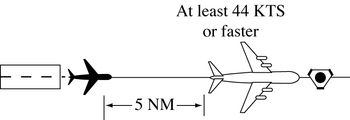 5 Miles Examples: 1. A departing aircraft follows a preceding aircraft which has taken off from the same or adjacent airport. 2. A departing aircraft follows a preceding en route aircraft which has reported over a fix serving the departure airport. |
|
6-4-2 When the leading aircraft maintains a speed at least 22 knots faster than the following aircraft - __ miles between DME equipped aircraft
|
 10 Miles Examples: 1. A departing aircraft follows a preceding aircraft which has taken off from the same or an adjacent airport. 2. A departing aircraft follows a preceding en route aircraft which has reported over a fix serving the departure airport. |
|
6-4-3 Separate aircraft traveling opposite courses by assigning different altitudes consistent with the approved vertical separation from __ minutes before, until __ minutes after they are estimated to pass
|
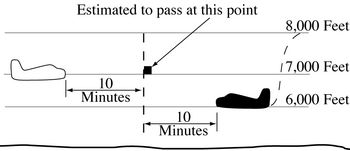 10,10 Vertical separation may be discontinued after one of the following conditions is met: A. Both aircraft have reported passing NAVAIDs, DME fixes, or waypoints indicating they have passed each other. b. Both aircraft have reported passing the same intersection/waypoint and they are at least 3 minutes apart. c. Two RNAV aircraft have reported passing the same position and are at least 8 miles apart if operating along a route that is 8 miles or less in width; or 18 miles apart if operating along an expanded route; except that 30 miles shall be applied if operating along that portion of any route segment defined by a navigation station requiring extended usable distance limitations beyond 130 miles. d. An aircraft utilizing RNAV and an aircraft utilizing VOR have reported passing the same position and the RNAV aircraft is at least 4 miles beyond the reported position when operating along a route that is 8 miles or less in width; 9 miles beyond the point when operating along an expanded route; except that 15 miles shall be applied if operating along that portion of any route segment defined by a navigation station requiring extended usable distance limitation beyond 130 miles; or 3 minutes apart whichever is greater. |
|
6-5-3 A Between different arcs about a NAVAID regardless of direction of flight:
1. At 35 miles or less from the NAVAID- __ miles.
2. More than 35 miles from the NAVAID- __ miles.
|
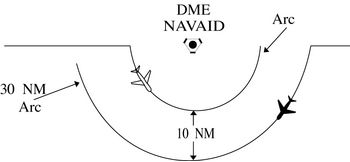 10,20 |
|
6-5-3 B Between an arc about a NAVAID and other airspace to be protected:
1. At 35 miles or less from the NAVAID- __ miles.
2. More than 35 miles from the NAVAID- __ miles.
|
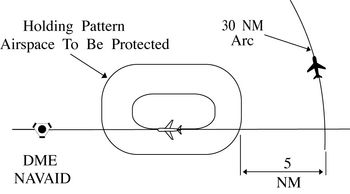 5,10 |
|
6-6-2 Assign an altitude to an aircraft only after the aircraft previously at that altitude has reported at or passing through another altitude separated from the first by the appropriate minimum when:
|
A. Severe turbulence is reported.
b. Aircraft are conducting military aerial refueling. c. The aircraft previously at the altitude has been: 1. Issued a clearance permitting climb/descent at pilot's discretion. 2. Cleared to CRUISE (altitude). However, do not use Mode C to effect separation with an aircraft on a cruise clearance. |
|
6-6-3 T/F When pilots of aircraft in direct radio communication with each other during climb and descent concur, you may authorize the lower aircraft, if climbing, or the upper aircraft, if descending, to maintain vertical separation.
|
TRUE
|
|
6-1-4. The ATC facility providing service to heavy jets/B757s and having control jurisdiction at adjacent airports shall separate arriving or departing IFR aircraft on a course that will cross behind the flight path of a heavy jet/B757 _____
|
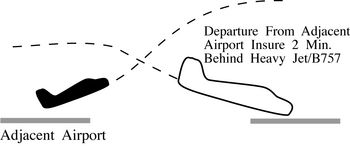 2 MINUTES |
|
6-1-5. Separate IFR aircraft landing behind an arriving heavy jet/B757 by 2 Minutes when arriving:
A. B. C. |
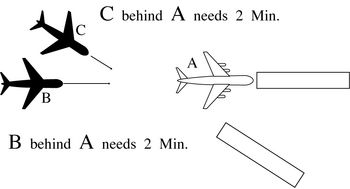 A. The same runway (use 3 minutes for a small aircraft behind a heavy jet/B757). B. A parallel runway separated by less than 2,500 feet. C. A crossing runway if projected flight paths will cross. |
|
Section 6-2-1 A. When aircraft will fly diverging courses: 1. Immediately after takeoff - ___ until courses diverge. 2. Within 5 minutes after takeoff- ___ until courses diverge. 3. Within 13 miles DME/LTD after takeoff - ____ until courses diverge.
|
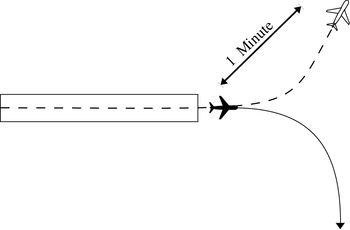 1 Minute, 2 Minutes, 3 Miles |



